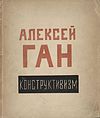Constructivist International
Constructivist International (German: Konstruktivistische Internationale, KI) was an international organisation made up of avant-garde artists established in 1922 in order to co-ordinate the work of constructivist artists as an international collective style.
The International Constructivist Faction[]

The concept of the Constructivist International was first proposed at the International Congress of Progressive Artists, held in Düsseldorf, 29-31 May 1922.[1] A few days prior to the Congress, the key actors involved in launching the KI, met together in Weimar: Theo van Doesburg, El Lissitzky, Hans Richter, Werner Graeff, Karl Peter Röhl and Cornelis van Eesteren. Although they did not develop a unified position, they did develop a shared view on organising avant-garde artists internationally in the interests of social transformation rather than simply aesthetic issues or the pragmatic issues of organising exhibitions, music festivals etc.[1]
During the first day, the Young Rhineland group presented their proposed proclamation, creating some dissent when they suggested that those who did not want to sign it should leave the congress.
References[]
- ^ Jump up to: a b Margolin, Victor (1997). The Struggle for Utopia: Rodchenko, Lissitzky, Moholy-Nagy, 1917-1946: Rodchenko, Lissitzky, Moholy-Nagy, 1917-46. Chicago: University of Chicago Press.: 58
- Art movement stubs
- Art movements
